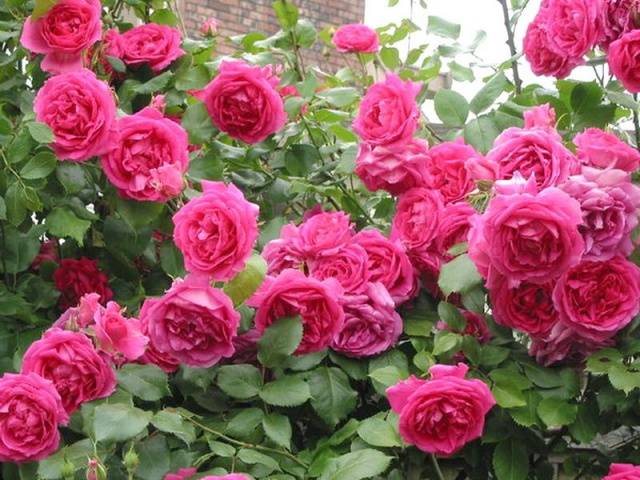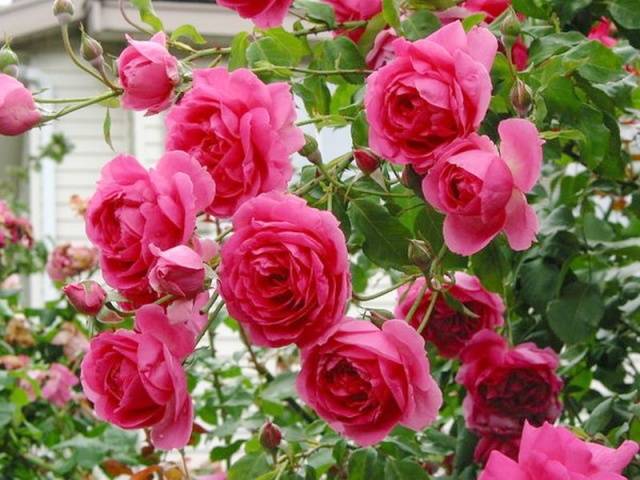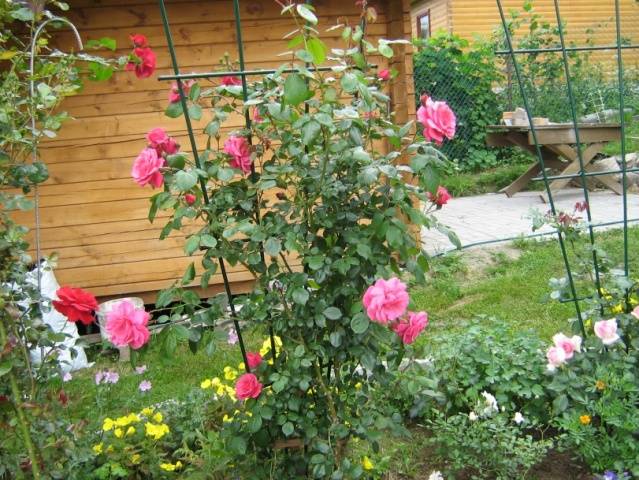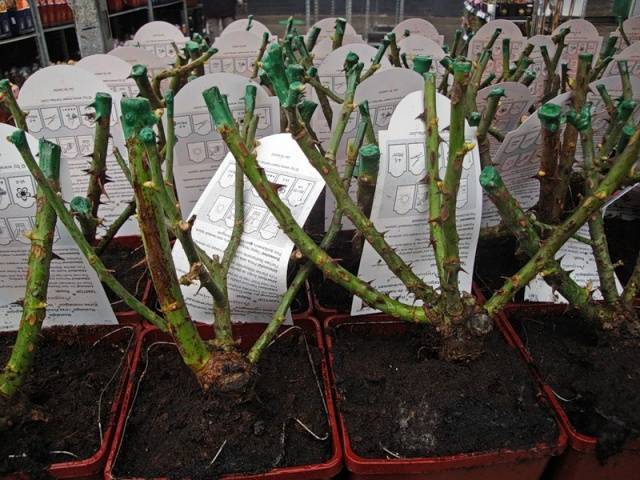Climbing roses occupy a special place among all the flowers that we plant in our personal plots. They are able to bring special tenderness and beauty to any, even the smallest garden. Most varieties climbing roses belong to the old selection and have a long history. But among them there are also relatively fresh varieties that appeared in the XX-XXI century. These varieties include climbing rose Parade (Parad).
Description of the variety
The Climbing Rose Parade was introduced in America in 1953. It was based on the incredibly popular New Dawn variety, which is distinguished by its fabulous beauty and unpretentiousness. The similarity of these varieties can be estimated from the photo below.
The parade belongs to the class of large-flowered roses of the climber group. He has large, powerful and voluminous bushes. They adapt very easily to any soil, starting to branch out vigorously. This feature allows the Parada bushes to grow rather quickly, acquiring impressive sizes. The maximum height of this climbing rose variety will be about 3.5 - 4 meters with a width of 2 meters.
The shoots of the Parade rose are thin and very flexible. During the flowering period, they can lean to the ground under the weight of the flowers.
The leaves on the shoots of this variety have a rich emerald color. They are very delicate and delicate in texture. Due to this, even non-flowering bushes acquire a special decorative effect. But of course, the decorativeness of this variety is fully revealed during flowering. The flowering bushes of the Parade variety are an incredible sight that immerses the entire garden in the atmosphere of a classic English estate. During the flowering period of Parada, the garden will be filled with a light, delicate and unusually pleasant floral scent.
At the very beginning of flowering, the Parada bushes are covered with oval buds, which will slowly and alternately open, exposing delicate double petals. Due to the large number of petals in the process of opening, the flowers acquire a lush cup-shaped shape. The fully opened double flowers of the Parade rose are large in size. Their average diameter will be about 9 - 10 cm. In this case, the flowers are formed either one at a time, or gather in groups of 5 pieces.
The color of the Parade rose is not uniform. The predominant color will be hot pink or cherry red. In the very center of the flower, the color will be darkest, and as it approaches the edge of the petals, it will fade. On the reverse side, the petals will have a muted color with a slightly silvery tint. In this case, the color of the Parada flowers will darken with each subsequent flowering, and it will bloom all summer. It is worth noting that the Parade blooms in full only in the second year after planting. In the first year, it will bloom slightly.
Climbing rose variety Parade can be planted either separately from other plants and flowers, or by combining them with each other. Excellent neighborhood Parade forms together with clematis and other climbing plants. As for the supporting structures, then the gardener will have a place to roam. Supports such as the following are perfect for the Parade:
- hedge;
- trellis;
- lattice;
- column;
- arch and other structures.
In addition, Parade can grow like a regular bush. To do this, its shoots will need to be cut when they reach the desired height.
Recommended fit and care
The parade will require increased attention only in the first year after disembarkation.From the second year on, his care needs are significantly reduced.
Parade should be planted in the same way as other varieties of climbing roses in late spring or early summer.
The characteristics of the Parade allow it to be planted in shaded areas. But the bushes of this variety will show the most abundant flowering only when planted in a sunny, well-ventilated place. In addition, when planted in a sunny place, rainwater will evaporate from the leaves faster, which means that the likelihood of fungal diseases will decrease. In terms of soil, Parade is also not very picky. It can grow on any soil, but it will show the best flowering only on loose and nutritious soil with good drainage.
Planting a rose Parade includes several stages:
- Soil preparation. To do this, you need to prepare a strip of soil about 50 cm wide. This strip must be dug deeply. For each bush, you need to make a hole in the size of the root system and add any available organic matter to it. Most often, for these purposes, they take rotted manure or compost, at the rate of half a bucket per hole.
- Soaking seedlings. To do this, add Kornevin or other growth stimulants to the water and lower the seedling into it for 30 minutes.
- Directly landing. The soaked seedlings are carefully immersed in the hole, straightening all the roots. After that, they are covered with earth and slightly compacted.
After planting, the Parade rose must be well watered and cut to a height of 15 cm. This is done to stimulate growth and abundant flowering.
Further care for a rose of this variety will consist in carrying out the following procedures:
- Watering every 10 days. On especially hot days, water the rose as the topsoil dries out.
- Top dressing. In the first year after planting, the rose will have enough fertilizer applied during planting. In the second year, the Parade must be fertilized with mineral and organic fertilizers, alternating between them. From the third year, only organic matter remains from fertilizers. At the same time, you can fertilize a rose no more than 5 times during the summer. Fertilize the Parade rose only before or after flowering.
- Pruning. It is essential for healthy growth and beautiful bush formation. Pruning should be done in autumn or spring. All dead and weak shoots must be removed. Pruning should be done with a sharp knife at an angle of 45 degrees above the kidney.
- Winter cleaning. To do this, the bush must be tilted to the ground as much as possible and covered first with dry leaves or spruce branches, and then with any non-woven fabric, for example, lutrasil. With the onset of spring, the shelter is removed. It is better to do this in cloudy weather, so as not to burn the bushes weaned from the sun. More about winter shelter of climbing roses you can learn from the video:
The climbing rose of the Parade variety is an excellent choice for those who love beauty and unpretentiousness. It shows itself well when grown in our climate, as evidenced by numerous reviews of gardeners.
















